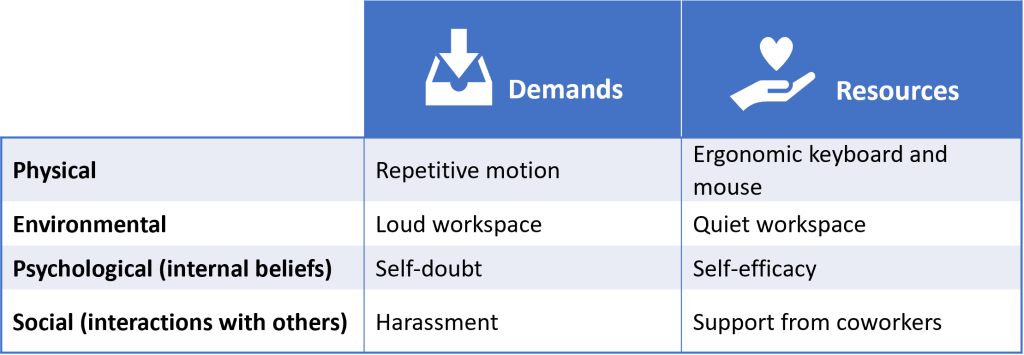New Burnout Prevention Training for Public Health
Posted on by
A new free online training, Understanding and Preventing Burnout among Public Health Workers: Guidance for Public Health Leaders will help managers and supervisors prevent burnout in the public health workers they lead and in themselves. The course, from the National Institute for Occupational Safety and Health, is part of a health worker mental health initiative.
Designed for supervisors to fit into their busy schedules, the 3.5 hour training is divided into three units. Each unit consists of 15 to 30 minute modules.
- Unit 1 – Burnout overview
- Unit 2 – Demands and resources that affect public health worker burnout
- Unit 3 – Interventions to reduce burnout risk
Each module features an instructional video, a knowledge check quiz, and additional resources for discussion and reflection. Participants are eligible to receive continuing education credits at no cost. Funded by NIOSH, the course was developed by Drs. Christopher Cunningham and Kristen Black, experts in industrial-organizational and occupational health psychology at the University of Tennessee at Chattanooga.
The COVID-19 pandemic placed additional strain on an already underfunded and understaffed public health workforce. Public health workers experiencing burnout often feel exhausted and cynical. Working in a distressing environment can strain a person’s physical, emotional, and psychological well-being. Burnout is linked to an increased risk of mental health conditions, such as anxiety and depression. Workers experiencing burnout may be less engaged at work and choose to leave their job or public health altogether.
Studies have documented burnout and its effects among public health workers throughout the pandemic:
- 66% of public health workers surveyed in 2020 experienced burnout [Stone et al 2021].
- 53% of state, tribal, local, and territorial public health workers surveyed in 2021 experienced symptoms of at least one mental health condition in the previous two weeks. The most common conditions were depression, anxiety, and post-traumatic stress disorder [CDC 2022].
- 40% of the public health workforce surveyed in 2021-2022 intended to leave their job in the next five years [CDC 2022].
Burnout develops when workers experience a chronic imbalance between demands and the resources needed to respond effectively to those demands. Unit 2 of this training describes demands that public health workers face and associated resources that can help. Below are just a few examples.

Unit 3 of this training describes strategies for reducing and preventing burnout. It offers a multilevel perspective on burnout interventions using the IGLOO model [Nielson et al. 2018]. This serves as a framework to focus attention on Individual, Group, Leader, Organizational, and Overarching context level considerations. For example, at the leadership level, an organizational intervention might be to improve performance feedback systems. An individual level intervention is being a good role model as a supervisor by taking vacation days. The training ends with an intervention planning guide. It’s designed to help managers and supervisors identify key demands, resources, and opportunities for change at each level.
The training is designed to empower public health leaders, managers, and supervisors to make practical and empirically supported changes in the work environment to reduce workers’ burnout risk. As emphasized throughout this training, leaders, managers, and supervisors play an essential role in protecting workers from burnout. Although individual-level interventions to improve self-care and resilience can be helpful, organizations also need to make changes to address root causes of burnout. In this new online training, public health leaders can learn strategies to prioritize employee health and well-being and prevent burnout.
Participate in this training today! Visit Understanding and Preventing Burnout among Public Health Workers: Guidance for Public Health Leaders
Emily Novicki, MA, MPH, is a Health Scientist in the NIOSH Office of the Director.
Christopher J. L. Cunningham, PhD, is a Guerry Professor and UC Foundation Professor of Psychology at The University of Tennessee at Chattanooga.
Kristen J. Black, PhD, is an associate professor in the Department of Psychology at the University of Tennessee at Chattanooga.
L. Casey Chosewood, MD, MPH, is Director of the NIOSH Office for Total Worker Health.
Thomas Cunningham, PhD, is a Senior Scientist in the NIOSH Division of Science Integration (DSI).
References
CDC [2022]. Symptoms of Depression, anxiety, post-traumatic stress disorder, and suicidal ideation among state, tribal, local, and territorial public health workers during the COVID-19 pandemic — United States, March–April 2021. MMWR 70(48): 1680–1685, https://www.cdc.gov/mmwr/volumes/70/wr/mm7048a6.htm?s_cid=mm7048a6_w
CDC [2022]. Workplace Perceptions and experiences related to COVID-19 response efforts among public health workers — Public Health Workforce Interests and Needs Survey, United States, September 2021–January 2022. MMWR 71(29): 920–924, https://www.cdc.gov/mmwr/volumes/71/wr/mm7129a3.htm
Nielsen, K., Yarker, J., Munir, F., & Bültmann, U [2018]. IGLOO: An integrated framework for sustainable return to work in workers with common mental disorders. Work & Stress, 32(4), 400-417. https://doi.org/10.1080/02678373.2018.1438536
Stone et al [2021]. Public health workforce burnout in the COVID-19 response in the U.S. Int J Environ Res Pub Health 18:4369, https://doi.org/10.3390/ijerph18084369
Posted on by

